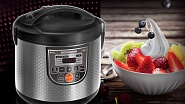How to Convert a Recipe Into a Pressure Cooker Recipe

Ready to embrace the new and convert your favorite recipe into pressure-cooker ready? Here's how.
1. Pick A Well-Suited Recipe
Pressure cookers require liquid to attain pressure, so ideally it should have liquid. Soups, legume, grain, meat and most slow cooker recipes are typical recipes that can easily adapt.
If you have stubborn and fatty meats, they can be tenderised into succulent dishes. Lean meat like pork loin will only dry out under high pressure.
Braises and soups are perfect. Cooking time for soup can be significantly shortened, yet flavors compare to that which have simmered for hours.
Dried beans can be cooked in a breeze while vegetables become incredibly delicious such that it pleases the pickiest of kids!
2. Determine Cook Time
In anything you pressure cook, leave enough room for steam to build up. High pressure is set as default, but medium or low pressure may be used for delicate ingredients like custards and seafood to lessen the chance of overcooking. Cook time may be a bit longer, but still shorter than traditional stovetop simmering or using the oven.
Reduce meat recipes meant for cooking in the oven or stove to a third, while cook time for pasta is generally reduced to half. Beans usually take only a quarter of the total length of the process. Don't be surprised if a 6-hour cook time drops to just around 10 minutes!
3. Gauge the Amount of Liquid to Use
Generally, you should add 1 cup of liquid. Very little liquid is lost during pressure cooking, so you may need to pour even less with foods that already have high water content. The amount of water for regular recipes for soups and braises should be greatly reduced so you don't water down the flavor.
4. Deciding Between A Natural or Quick Release
A natural release is beneficial for meat, but pasta and vegetables that are likely to get overcooked would need a quick release. A natural release implies that once the machine beeps and cook time is over, you let it sit for 10 to 20 more minutes to perfection. By doing so, no steam spurts out upon turning the valve from sealing to venting.
5. General Pressure Cooker Converting Guidelines
Here are 5 tips to help you use multicooker like a pro:
- Don't roll meat into flour before browning. Simply heat some oil and your pressure cooker will do a great job.
- Cornstarch and flour should be added towards the end to achieve the ideal sauce consistency.
- Rice and pasta should be cooked separately to avoid starchiness, then added to the pot right before serving.
- Dairy products, milk and cheeses should be added after pressure cooking to prevent curdling.
- Keep a notebook for future reference so you can adapt and tweak the recipe accordingly to your taste.
Read also:
-
 26 June 2017 Best Pressure Cooker Desserts
26 June 2017 Best Pressure Cooker Desserts -

-
 28 May 2017 Top 8 Summer Salads
28 May 2017 Top 8 Summer Salads
You found 120 egg(s) and 23 rabbit(s). Your discount — 20%!











